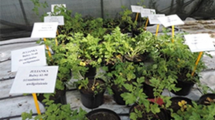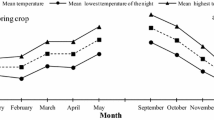Summary
Potato plants (Solanum tuberosum L. cv. Ostara) were grown in nutrient solution culture in a controlled environment. Growth rates of individual tubers were determined daily by measuring the increase in their volume. Decreasing the source:sink ratio of individual plants by removing half of the leaf area, decreased tuber growth rate per plant by 50%. Increasing the source: sink ratio of individual plants by cooling to 8°C, or by removing individual tubers of known growth rate, increased the growth rate of non-cooled, remaining tubers within 2–4 days.
The potential of the tubers to increase their growth rates was not related to the date of tuber removal after tuber initiation. It is concluded that during the phase of linear tuber bulking, tuber growth is neither limited by pathway nor sink, but by the source capacity of the plant.
Zusammenfassung
Kartoffelpflanzen (Solanum tuberosum L. cv. Ostara) wuchsen in Nährlösung unter kontrollierten Umweltbedingungen (14 h Tageslänge, 22°C/18°C Tag/Nachttemperatur, 60–80% relative Luftfeuchtigkeit, Licht-intensität in Pflanzenhöhe ≈380 μE m−2 s−1). Die Wachstumsraten der einzelnen Knollen wurden täglich aus ihrer Volumenzunahme bestimmt. Die Auswirkungen von Source- und Sink-Manipulationen auf die Wachstumsraten der Knollen wurden während der Phase linearen Knollenwachstums untersucht.
Eine Reduzierung der Source-Stärke einzelner Pflanzen durch Entfernen jedes 2. Fiederblattes oder eines von 2 gleichwertigen hauptstengeln pro Pflanze bewirkte eine sofortige Abnahme des Knollenwachstums pro Pflanze um 50% (Abb. 4). In den meisten Fällen nahm auch die Wachtstumsrate der einzelnen Knollen an den Pflanzen um etwa 50% ab (Abb. 5).
Durch Kühlung einzelner Knollen auf +8°C wurden deren Wachstumsraten im Durchschnitt von 4,5 auf 1,6 cm3 d−1 gesenkt, während gleichzeitig die Wachstumsraten der ungekühlten Knollen von 2,8 auf 5,2 cm3 d−1 anstiegen (Tab. 1). Das Entfernen einzelner Knollen, die bis dahin durch-schnittlich zu 60% am Gesamtknollenwachstum pro Pflanze beteiligt waren, führte innerhalb von 2–4 Tagen zu einem mehr als doppelt so schnellen Wachstum der an den Pflanzen verbliebenen Knollen, so dass das Gesamtknollenwachstum pro Pflanze nicht signifikant verändert wurde (Abb. 1). Hierbei wurden die Wachstumsraten aller an der Pflanze verbliebenen Knollen erhöht, wobei Wachstumsraten von mehr als 8 cm3 pro Einzelknolle und Tag erreicht wurden (Abb. 3). Die Fähigkeit der Knollen, ihre Wachstumsrate dem jeweiligen Assimilatangebot anzupassen, war nicht davon abhängig, zu welchem Zeitpunkt nach der Knolleninduktion (10–30 d) einzelne Knollen entfernt wurden (Abb. 2).
Aus den Untersuchungen wird gefolgert, dass in der phase des linearen Knollenwachstums eine Limitierung des Knollenwachstums weder durch den transportweg noch durch die Speicherfähigkeit der Knollen bewirkt wird, sondern durch die Fähigkeit des oberirdischen Sprosses, Assimilate zur Verfügung zu stellen.
Résumé
Des plantes de pommes de terre (Solanum tuberosum L. cv. Ostara) sont cultivées dans une solution nutritive sous atmosphère contrôlée (longueur de jours 14 h; températures jour/nuit 22°C/18°C; humidité relative de l'air 60 à 80%; intensité du rayonnement photosynthétique à hauteur de la plante ≃380 μF m−2 s−1).
Le grossissement des tubercules est déterminé chaque jour en mesurant l'augmentation de leur volume. Les effets de la source d'assimilation et du puits d'absorption sont analysés pendant la phase linéaire de grossissement des tubercules.
Une diminution du rapport source: puits d'absorption est obtenue en supprimant la moitié de la surface foliaire de chaque plante. Le grossissement des tubercules diminue en conséquence de 50% (figure 4). Mis à part quelques exceptions, les taux de croissance des tubercules individuels baissent également de 50% (figure 5).
Le refroidissement de certains tubercules d'une même plante à 8°C entraîne une diminution moyenne de leur grossissement de 4,5 à 1,6 cm3/jour. Dans le même temps, les autres tubercules voient leur croissance augmenter de 2,8 à 5,2 cm3/jour (tableau 1). La suppression de certains tubercules qui avaient contribué pour 60% au grossissement total obtenu par plante, entrîne une augmentation de croissance de plus de 100% des tubercules restants, ceci en moins de 2 à 4 jours. De ce fait, la croissance totale, par plante n'est pas significativement inférieure (figure 1).
Après suppression de certains tubercules, on constate que pour tous les tubercules restants leur grossissement augmente et le taux maximum de croissance atteint 8 cm3/jour (figure 3).
Les tubercules ajustent leur grossissement en fonction de l'apport effectif de photosynthèse sans liaison avec la date de suppression de certains tubercules après leur initiation (figure 2).
En conclusion, pendant la phase linéaire de grossisement, la croissance des tubercules n'est pas limitée par le puits d'absorption, mais par la capacité de la source d'assimilation de la plante.
Similar content being viewed by others
References
Allen, E. J. & R. H. Scott, 1980. An analysis of growth of the potato crop.Journal of Agricultural Science, Cambridge 94: 583–606.
Bremner, P. M. & M. A. Taha, 1966. Studies in potato agronomy. I: The effect of variety, seed size and spacing on growth, development and yield.Journal of Agricultural Science, Cambridge 66: 241–252.
Burton, W. G., 1964. The respiration of developing potato tubers.European Potato Journal 7: 90–101.
Crafts, A. S., 1933. Sieve tube structure and translocation in the potato.Plant Physiology 8: 81–104.
Engels, C., 1983. Wachstumsrate der Knollen vonSolanum tuberosum var. Ostara in Abhängigkeit von exogenen und endogenen Faktoren—Konkurrenz zwischen Einzelknollen um Assimilate. Dissertation, Universität Hohenheim, FRG.
Engels, C. & H. Marschner, 1986. Allocation of photosynthate to individual tubers ofSolanum tuberosum L. III. Relationship between growth rate of individual tubers, tuber size and stolon growth prior to tuber initiation.Journal of Experimental Botany 37: 1813–1822.
Gifford, R. M. & J. Moorby, 1967. The effect of CCC on the initiation of potato tubers.European Potato Journal 10: 235–238.
Gray, D. & J. C. Holmes, 1970. The effect of short periods of shading at different stages of growth on the development of tuber number and yield.Potato Research 13: 215–219.
Hartz, T. K. & F. D. Moore III, 1978. Prediction of potato yield using temperature and insolation data.American Potato Journal 55: 431–436.
Krauss, A., 1978. Tuberization and abscisic acid content inSolanum tuberosum as affected by nitrogen nutrition. Potato Research 21: 183–193.
Krauss, A. & H. Marschner, 1971. Auftreten von Calciummangelnekrosen an Kartoffelstolonen.Zeitschrift für Pflanzenernährung und Bodenkunde 129: 89–91.
Krauss, A. & H. Marschner, 1984. Growth rate and carbohydrate metabolism of potato tubers exposed to high temperatures.Potato Research 27: 297–303.
Marschner, H., B. Sattelmacher & F. Bangerth, 1984. Growth rate of potato tubers and endogenous contents of indolylacetic acid and abscisic acid.Physiologia Plantarum 60: 16–20.
Moll, A. & W. Henninger, 1978. Genotypische Photosyntheserate von Kartoffeln und ihre mögliche Rolle für die Ertragsbildung.Photosynthetica 12: 51–61.
Moorby, J., 1968. The influence of carbohydrate and mineral nutrient supply on the growth of potato tubers.Annals of Botany 32: 57–68.
Moorby, J. & F. L. Milthorpe, 1974. Potato. In: L. T. Evans (Ed.), Crop physiology—Some case histories, p. 225–257. Cambridge University Press, Cambridge.
Plaisted, P. H., 1957. Growth of the potato tuber.Plant Physiology 32: 445–453.
Reeve, R. M., H. Timm & M. C. Weaver, 1973. Parenchyma cell growth in potato tubers. I. Different tuber regions.American Potato Journal 50: 49–57.
Sale, P. J. M., 1973. Productivity of vegetable crops in a region of high solar input. I. Growth and development of the potato (Solanum tuberosum).Australian Journal of Agricultural Research 24: 733–749.
Sale, P. J. M., 1976. Effect of shading at different times on the growth and yield of the potato.Australian Journal of Agricultural Research 27: 557–566.
Steineck, O., 1959. Der Ertragsaufbau der Kartoffel.Bodenkultur 10: 231–245.
Winkler, E., 1971. Kartoffelbau in Tirol. II. Photosynthesevermögen und Respiration von verschiedenen Kartoffelsorten.Potato Research 14: 1–18.
Author information
Authors and Affiliations
Rights and permissions
About this article
Cite this article
Engels, C., Marschner, H. Effects of reducing leaf area and tuber number on the growth rates of tubers on individual potato plants. Potato Res 30, 177–186 (1987). https://doi.org/10.1007/BF02357661
Accepted:
Issue Date:
DOI: https://doi.org/10.1007/BF02357661




